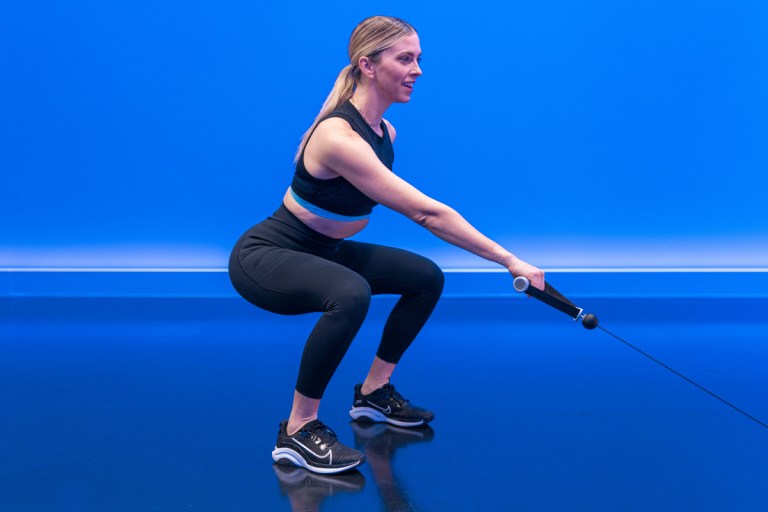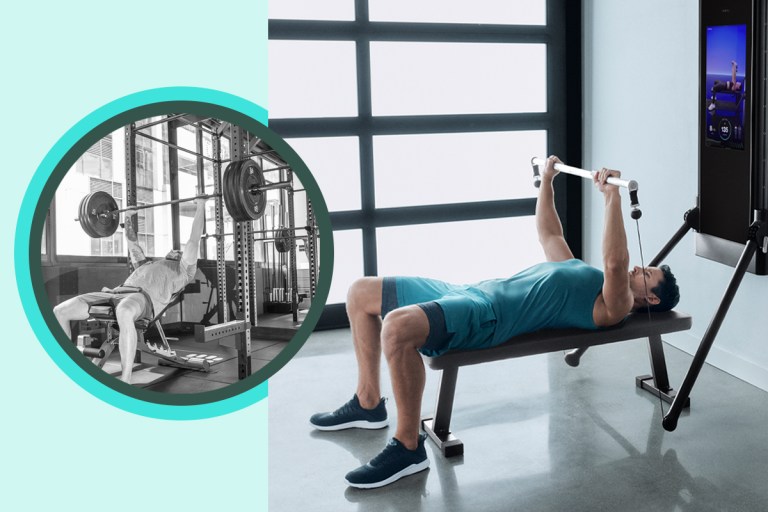What’s the Difference Between Steady-State Cardio and Intervals?

Here’s how steady-state cardio and intervals measure up in terms of intensity level and benefits—and why both deserve a spot in your routine.
While certified personal trainer and Tonal coach Ash Wilking is well-versed in all the benefits of strength training, she also knows that her fitness routine wouldn’t be complete without a healthy dose of cardio. “There’s one big goal: to improve fitness. Cardiovascular work is an important part of that,” she says.
There are some perks to cardiovascular exercise—any activity that raises your heart rate and breathing rate—that you can’t get from just lifting. “In general, it’s one of the best things you can do for heart health,” says Jenna Moore, a certified strength and conditioning coach and Programming Specialist at Tonal. Cardio exercise has been shown to improve lipid profiles, lower resting heart rate, improve glucose tolerance, increase endurance, and build lung capacity.
Just like there are multiple types of resistance training—including hypertrophy, max strength, and metabolic—cardio exercise comes in different flavors. Cardio primarily breaks down into two types: steady-state and interval. As an endurance athlete, Wilking uses both types to prepare for racing triathlons, but even if you’re not signing up for an Ironman race anytime soon, there are lots of reasons why these different types of cardio are worth your time.
Steady-State Cardio
Any activity that gets your heart rate up and that you can maintain for at least five minutes at a time—such as walking briskly, jogging, cycling, hiking, or dancing—can be a form of steady-state cardio. “It’s cardio without a significant change in intensity,” says Wilking. “There’s no big shift in how hard you’re going.”
As for how steady-state cardio should feel, Moore says your rate of perceived exertion (RPE) should be around a four to six on a scale of one to 10. Your breathing rate will increase, she explains, but you should still be able to hold a conversation. Physiologically, when you’re exercising at this moderate intensity level, your body is able to provide enough oxygen to meet your energy needs. “The effort and the energy required are in homeostasis,” she says. This allows your muscles to continue working for longer durations by training the highly fatigue-resistant slow-twitch muscle fibers.
Working at a sustained intensity level strengthens the heart and creates adaptations on a cellular level that boost your stamina. “Steady-state cardio stimulates increases in the number of mitochondria—where your cells produce energy—to help your muscle cells keep up with increased energy demands. This helps to improve muscle endurance,” says Moore. “Likewise, the heart will adapt to increases in oxygen demands by increasing cardiac output so oxygen can be more easily delivered to the working muscle cells. This increases aerobic capacity, allowing you to avoid getting winded going up and down stairs or playing a game of basketball with your children.”
Another big perk of steady-state cardio, according to Wilking, is how accessible it is no matter your fitness level. “It’s low impact and, for the most part, anyone can do it,” she says. “There really is some validity behind [the idea] of just getting moving and just getting your heart rate up enough.” For more advanced athletes who spend several days each week lifting heavy or doing more intense cardio exercise, Wilking says cruising along on an easy jog or bike ride can also be a form of active recovery, getting the blood flowing to promote healing and reduce soreness.
Interval Cardio
Unlike steady-state cardio, where you maintain the same effort over time, interval training is all about pushing the intensity for short periods with breaks for rest or active recovery in between. “The main goal is to create that differentiation in intensity,” says Wilking.
Your effort level during intervals should be greater than during steady-state cardio, which is why you’re only able to maintain this intensity for seconds or minutes at a time. Moore explains that interval training is typically done at an intensity above your anaerobic threshold, the point at which lactate (a byproduct of energy metabolism) builds up in your blood at a rate faster than your body can clear it.
You can do interval training while running, swimming, or biking, or with bodyweight exercises such as jumping jacks, burpees, or skater bounds. Additionally, intervals can be performed with resistance exercises that combine the benefits of strength training and cardio. You’ll typically see this type of work in metabolic resistance training or high-intensity resistance training, where the goal is building lean muscle while burning fat and improving work capacity. In these workouts, you’ll usually lift lighter weights and go for speed in duration-based intervals.
Moore breaks down interval training into three general effort ranges of increasing intensity: vigorous (RPE of 7-8 for intervals lasting 90 seconds to 4 minutes); very hard (RPE of 9 for 30-90 second intervals); and max effort (all-out, RPE of 10 for under 30 seconds). As the intervals get shorter and more intense, you should be breathing heavier and feel your heart beating faster.
You can also manipulate the difficulty of an interval workout by changing the work-to-rest ratio. The less time you have for rest in-between intervals, the more challenging the workout. “If your [desired] outcome is improving cardiovascular conditioning or anaerobic threshold, then we’re going to start to tighten up those rest periods,” says Moore. One example of a tough conditioning workout is a Tabata session, which pairs 20-second all-out busts with just 10 seconds of rest. Short rest periods keep your heart rate elevated so you’re working at a harder intensity level overall throughout your workout even if you’re only sustaining your all-out efforts for seconds at a time.
While interval training offers many of the same cardiovascular benefits of steady-state training, it helps you achieve them more efficiently. “You’re going to burn the same amount of calories, if not more, in much less time,” says Moore.
Interval training also helps develop fast-twitch muscle fibers which are responsible for powerful, explosive movements such as sprinting or powerlifting. “Muscle hypertrophy [and] increases in strength or explosiveness can all be seen with this type of training,” says Moore. “So, if you’re looking for something that gives you physiological and aesthetic benefits, interval training will do the trick.”
The Bottom Line
Cardiovascular exercise provides unique physiological benefits that you can’t get from strength training alone. That’s why it’s essential to incorporate both in your training. Ideally, you should also include a mix of steady-state and interval cardio in your routine to get the benefits of both types of exercise. “Balance is going to be your best friend,” says Wilking. At a minimum, she recommends trying to do two full-body strength workouts, one steady-state cardio, and one-interval cardio session per week. As a guideline, the American College of Sports Medicine recommends at least 150 minutes of moderate-intensity cardio or 75 minutes of vigorous cardio per week.
However, Moore points out that both types may not be appropriate for everyone. Interval training may be too intense for beginner exercisers while steady-state cardio may aggravate existing overuse injuries. “It’s best to do whatever variation of training you can be consistent and safe with,” she says. “Consistency is what will lead to the benefits of increased cardiorespiratory conditioning and endurance.”
Cardio Workouts on Tonal
There are plenty of ways to get your heart rate up on Tonal, including high-intensity lifting sessions and bodyweight interval workouts. Try one of these workouts to get your blood pumping and improve your cardiovascular health.
Steady State Cardio – Coach Joe Rodonis
In this quick but effective workout, you’ll break a sweat while giving an even, controlled effort from start to finish. It’s great for beginners looking to get a feel for the appropriate intensity level of steady-state cardio.

Full-Body Mobility Flow – Coach Kendall “Woody” Wood
Moore explains that this workout uses “aerobic mobility” as a type of steady-state cardio. Because you’ll be moving through mobility exercises at a steady pace, it will get your heart rate slightly elevated and probably make you break a light sweat while improving range of motion and easing muscle tightness.

Intro to Intervals – Coach Ackeem Emmons
Give intervals a try in this beginner-friendly, low-impact workout. Using all bodyweight exercises, you’ll fire up your muscles while elevating your heart rate. Active recovery gives your body time to rest between more intense efforts.

Cardio for Calorie Burn – Coach Tim Landicho
Up the challenge of your interval workout with this high-intensity, full-body session. It’s fast-paced with short rest periods to increase your heart rate and get the sweat flowing.

20-in-20: Metabolic Burn – Coach Ash Wilking
Wilking’s four-week high-intensity program combines the benefits of strength training and interval cardio to build lean muscle and torch calories.
- WORKOUTS


